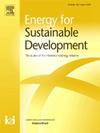垃圾衍生燃料生产的潜在收入和环境影响之间的权衡:基于印度尼西亚南坦格朗市新鲜废物和采矿废物组成的模拟研究
IF 4.9
2区 工程技术
Q2 ENERGY & FUELS
引用次数: 0
摘要
垃圾衍生燃料(RDF)作为处理大量城市固体废物(MSW)、延长垃圾填埋场寿命以及促进材料和热回收的一种有前途的解决方案,在印度尼西亚越来越受欢迎。RDF的数量和质量严重依赖于输入废物组成和用于RDF生产的材料选择,直接影响RDF销售的潜在收入和RDF项目的财务可持续性。本研究分析了印度尼西亚万丹省南坦格朗市新鲜废物和填埋采矿废物的组成,为战略RDF生产提供信息。一项比较模拟研究了八种不同的RDF生产方案中潜在的产量、热值、预期收入和温室气体(GHG)排放,这些方案在废物来源和材料选择上有所不同。在从新鲜和采矿废物中产生的RDF的潜在收入和环境影响,特别是温室气体排放之间确定了明确的权衡。利用垃圾填埋场采矿废物的方案产生了最高的预期收入,但也导致了最高的温室气体排放。对于新鲜废物RDF,包括RDF流中的有机废物和可燃可回收废物,由于产量和热值的增加,预计将产生更高的收入,而不是回收它们进行单独的再循环。这些发现为RDF生产者、接受者和决策者在选择RDF生产策略时提供了有价值的指导,以平衡数量、质量、经济可行性和环境影响。本文章由计算机程序翻译,如有差异,请以英文原文为准。
Trade-offs between potential revenue and environmental impacts for refuse-derived fuel production: A simulation study based on the composition of fresh and mining waste in South Tangerang City, Indonesia
Refuse-Derived Fuel (RDF) is gaining popularity in Indonesia as a promising solution for processing large volumes of municipal solid waste (MSW), extending landfill lifespans, and facilitating both material and thermal recycling. The quantity and quality of RDF are critically dependent on the input waste composition and the selection of materials for RDF production, directly impacting potential revenue from RDF sales and the financial sustainability of RDF projects. This study analysed the composition of fresh waste and landfill mining waste in South Tangerang City, Banten Province, Indonesia to inform strategic RDF production. A comparative simulation examined the potential production quantity, calorific value, expected revenue, and greenhouse gas (GHG) emissions across eight distinct RDF production scenarios, differing in waste source and material selection. A clear trade-off was identified between potential revenues and environmental impacts, specifically GHG emissions, for RDF produced from both fresh and mining waste. Scenarios utilising landfill mining waste yielded the highest expected revenues but also resulted in the highest GHG emissions. For fresh waste RDF, including both organic waste and combustible recyclable waste in the RDF stream, rather than recovering them for separate recycling, was projected to generate higher revenues due to increased production volume and calorific value. These findings offer valuable guidance for RDF producers, off-takers, and policymakers in selecting RDF production strategies that balance quantity, quality, economic viability, and environmental impact.
求助全文
通过发布文献求助,成功后即可免费获取论文全文。
去求助
来源期刊

Energy for Sustainable Development
ENERGY & FUELS-ENERGY & FUELS
CiteScore
8.10
自引率
9.10%
发文量
187
审稿时长
6-12 weeks
期刊介绍:
Published on behalf of the International Energy Initiative, Energy for Sustainable Development is the journal for decision makers, managers, consultants, policy makers, planners and researchers in both government and non-government organizations. It publishes original research and reviews about energy in developing countries, sustainable development, energy resources, technologies, policies and interactions.
 求助内容:
求助内容: 应助结果提醒方式:
应助结果提醒方式:


